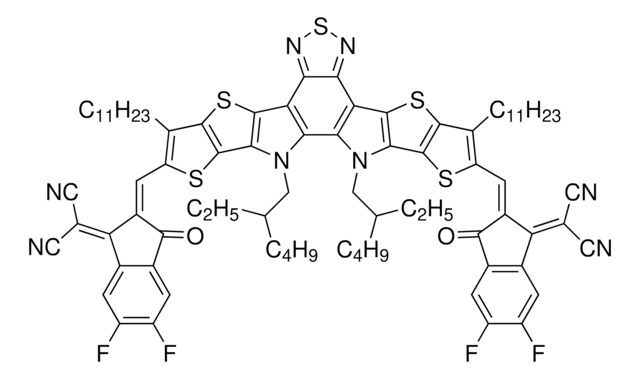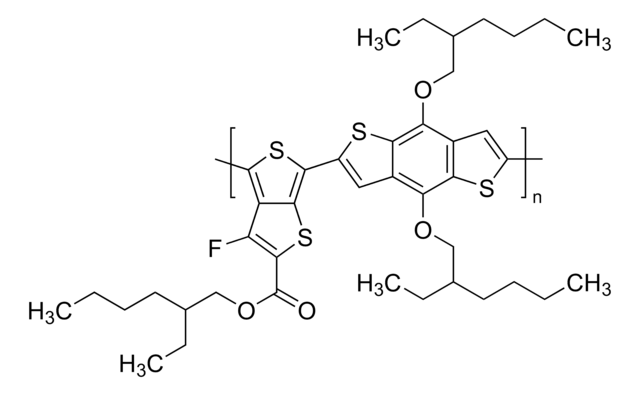Wichtige Dokumente
906387
ITIC-Cl
Synonym(e):
3,9-bis(2-methylene-((3-(1,1-dicyanomethylene)-6,7-dichloro)-indanone))-5,5,11,11-tetrakis(4-hexylphenyl)-dithieno[2,3-d:2′,3′-d′]-s-indaceno[1,2-b:5,6-b′]dithiophene, ITIC-2Cl
Größe auswählen
About This Item
Empfohlene Produkte
Beschreibung
Band gap: 1.48 eV
Assay
98%
Form
powder
Energie der Orbitale
HOMO -5.68 eV
LUMO -4.20 eV
SMILES String
[s]1c2c([s]c(c2)\C=C%14/C(=O)c%15c(cc(c(c%15)Cl)Cl)C/%14=C(C#N)C#N)c3c1c4c(cc7c(c4)C(c%10c%11[s]c(cc%11[s]c%107)\C=C%12\C(=O)c%13c(cc(c(c%13)Cl)Cl)C\%12=C(C#N)C#N)(c9ccc(cc9)CCCCCC)c8ccc(cc8)CCCCCC)C3(c6ccc(cc6)CCCCCC)c5ccc(cc5)CCCCCC
InChI
1S/C94H78Cl4N4O2S4/c1-5-9-13-17-21-55-25-33-61(34-26-55)93(62-35-27-56(28-36-62)22-18-14-10-6-2)75-45-72-76(46-71(75)89-85(93)91-81(107-89)43-65(105-91)41-73-83(59(51-99)52-100)67-47-77(95)79(97)49-69(67)87(73)103)94(63-37-29-57(30-38-63)23-19-15-11-7-3,6
InChIKey
CGRWDQBQNINDAH-WJLAHIJSSA-N
Verwandte Kategorien
Allgemeine Beschreibung
Anwendung
Lagerklassenschlüssel
11 - Combustible Solids
WGK
WGK 3
Flammpunkt (°F)
Not applicable
Flammpunkt (°C)
Not applicable
Hier finden Sie alle aktuellen Versionen:
Analysenzertifikate (COA)
Die passende Version wird nicht angezeigt?
Wenn Sie eine bestimmte Version benötigen, können Sie anhand der Lot- oder Chargennummer nach einem spezifischen Zertifikat suchen.
Besitzen Sie dieses Produkt bereits?
In der Dokumentenbibliothek finden Sie die Dokumentation zu den Produkten, die Sie kürzlich erworben haben.
Kunden haben sich ebenfalls angesehen
Artikel
Professor Chen (Nankai University, China) and his team explain the strategies behind their recent record-breaking organic solar cells, reaching a power conversion efficiency of 17.3%.
Active Filters
Unser Team von Wissenschaftlern verfügt über Erfahrung in allen Forschungsbereichen einschließlich Life Science, Materialwissenschaften, chemischer Synthese, Chromatographie, Analytik und vielen mehr..
Setzen Sie sich mit dem technischen Dienst in Verbindung.






![[6,6]-Phenyl C71 Buttersäuremethylester, Isomerengemisch 99%](/deepweb/assets/sigmaaldrich/product/structures/716/624/9fb9f2f0-ae99-429f-8d3a-b12267976a4d/640/9fb9f2f0-ae99-429f-8d3a-b12267976a4d.png)



